Purple Phoenix Games (2266 KP) rated Cult of the Deep in Tabletop Games
Feb 24, 2021
Cult of the Deep is a dice-driven, fantasy horror, hidden role game with similarities to some classic games. In it players will be donning the personas (personae?) of cultists with different roles and agendas. Players will be forming alliances with other cultists of unknown roles and possibly having their character perish and return to play as a Wraith with a totally new agenda. Each cultist’s role will have their own victory conditions to fulfill and the game ends once a player (or players) have fulfilling their victory conditions.
DISCLAIMER: We were provided a prototype copy of this game for the purposes of this review. These are preview copy components, and I do not know for sure if the final components will be any different from these shown. Also, it is not my intention to detail every rule in the game, as there are just too many. You are invited to download the rulebook, back the game through the Kickstarter campaign, or through any retailers stocking it after fulfillment. -T
Setup involves placing out the Altar Boards and Ritual Cards upon them. Players will also receive one Role, Character, Sigil, and Reference Card to use during play. Players will reveal their Character Cards and collect enough Life Tokens to equal what is shown upon these cards. Each set of dice and the coins are to be set on the table within reach. The player who received the High Priest Role Card reveals it, takes extra Life Counters, and becomes the first player. They take five Cultist Dice and the game may begin!
Each turn is divided into four phases: Roll, Commit, Response, Resolve. During the Roll phase the active player will roll five dice, and any dice may be re-rolled another two times. Once all re-rolls are complete or the player decides to stop, they will take each die and Commit them to other players, altars, or themselves. For example, if the player rolls two blood drop icons they may wish to heal themselves by two, so they can commit these dice to themselves. Should this player also have rolled any dagger icons they may commit these dice to other players in order to attack them for one life per icon. If any player has a special ability that can be enacted during the Response phase, they must now use it. One such ability may be turning a one-dagger icon into a two-dagger icon, or other abilities. Once all players have had a chance to activate any abilities during this phase, the dice must now be Resolved in any order of the active player’s choosing. So now the player can regain life counters (or even surpass their starting life total), attack other players’ life points, or activate any Altar abilities if dice were placed on Ritual Cards on altars.
The Resolve phase is where the action happens, and can lead to some serious actions. Players can be killed, Rituals can be activated, and players can be healed. If a Ritual is completed (no more activation slots remaining) during this phase, the active player becomes the Keeper of the Ritual and collects its card from the altar to be used for an immediate effect, or an ongoing effect for the rest of the game. Should a player be slain, they may return to the game as a Wraith, and thus draws a Wraith card (shown below) to now represent their altered state. Wraiths play the game differently, as they will not be able to commit any dice during their turn, but rather have their dice to be used during other cultists’ Response phases.
Play continues in this fashion of taking turns around the table until victory conditions have been met for a player or group of players. The game may be over, but the lasting effects of the results will remain in each player’s heart for some time.
Components. Again, this is a prototype copy of the game, so not all components are as they will be in the finished version. That said, we received an excellent prototype copy of the game. The cards are great, the cardboard components are equally great, and I know we were provided with examples of the Kickstarter exclusive add-on metal coins, but I certainly would spring for them. These coins are the real deal and just feel amazing to handle. I know the dice will be different upon a successful campaign, as stickered dice simply will not hold up to many plays (and I see on the KS page that the d4s will have numbers ON TOP, which is where they should be). So once all is said and done, I believe this will be a beautiful, if not dark, game with excellent components and art style.
I mentioned in my open that this game reminds me of bits of other classic games. Perhaps you were able to discern these in my description, but here are my thoughts. I enjoy dice-based hidden-role games like BANG! The Dice Game. Cult of the Deep feels similar in that players may suss out roles of other players simply by attacking them until roles are revealed or cultists slain. This is not the ideal strategy, as I have been repeatedly told by my wife, but it certain is effective. What is improved here is that players come back as Wraiths and really are not ever out of the game. This is very good, as I usually am the player who is ganged up on and first to exit any game of this type.
Secondly, rolling dice and then committing them to certain areas of the game feels extremely reminiscent of the classic Biblios. Biblios uses cards and each turn the different areas MUST be committed to, but here again Cult of the Deep improves on this mechanic by allowing the player to choose every location to which they wish to commit their dice. Maybe every turn a player will commit daggers to one player (more than likely the High Priest), or certain dice faces to heal another player, but it is not necessary, and always being aware of what faces the Rituals need to progress will also dissuade players from ganging on one player each turn.
I didn’t mention it in my description, but each player is also given a Sigil card that can be used once per game, and they are especially powerful. Having so many choices available during a turn, or even during other players’ turns makes this game unique and incredibly enjoyable.
If you are looking for a game that has that Cthulhu-esque theme, hints of other classic game mechanics, and a deluxe look, then Cult of the Deep is certainly highly recommended. It is a notch more difficult than BANG! The Dice Game, and utilizes Biblios’s resource allocation mechanic better, thus creating a great blend of each. I do think you should check out the Kickstarter campaign ending Wednesday, March 3, 2021 to back it and add it to your collection. Obviously, this isn’t for everyone, but if you have read this far, I will assume at least a small measure of interest. I believe it will be a great game to have available for the right group of people who can handle the theme and don’t mind dying and becoming a character in Lord of the Rings.
Samueljhague (1250 KP) rated The Castles of Burgundy in Tabletop Games
Mar 23, 2022
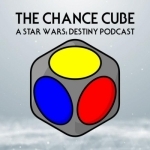
The Chance Cube - A Star Wars: Destiny Podcast
Podcast
A show by the fans, for the fans, about the fans of Star Wars: Destiny, a unique, collectible game...
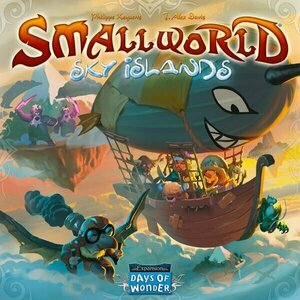
Small World Sky: Islands
Tabletop Game
Small World: Sky Islands introduces seven new races and powers to the Small World base game, but it...
Purple Phoenix Games (2266 KP) rated Tumble Town in Tabletop Games
Mar 5, 2020
Tumble Town is dice rolling, structure building, drafting game with variable player powers. You are charged with choosing building plans to be added to Main Street of Tumble Town. You do this throughout the game by selecting the plans that will make best use of the resources (dice) you gain. The buildings that you construct may allow you special powers to be used on future turns, or one-time bonuses to be used once built. The player who can turn the greatest profit (in terms of VP) at the end of the game will be the winner!
DISCLAIMER: We were provided a prototype copy of this game for the purposes of this review. These are preview copy components, and the final components will definitely be different from these shown. Also, it is not my intention to detail every rule in the game, as there are just too many. You are invited to back the game through the Kickstarter campaign, from your FLGS, or through any other retailers stocking it after fulfillment. -T
To setup, deal each player a packet of starting components: a unique Horse card, two reference cards, Storehouse card, Main Street card, and two brown (they are red in the prototype) dice to be rolled and placed within the Storehouse. Shuffle and display the 1-, 2-, and 3-cactus building cards per the rulebook instructions to form the market. Set aside a number of each die type per the rulebook (both the building cards and dice are determined by number of players). Determine the first player and give them the first player token (a colorful rubber potted cactus). Players will connect their two Main Street cards at the central icon to create a two-card street (we chose the wagon wheel – Easy) and the game can begin!
Turns in Tumble Town consist of four mini-phases that flow into each other rather naturally. The first phase will have the players choosing a revealed building plan card from the offer market. The face-down draw stack will inform the active player as to how many and which type of dice they must draw and roll. Once they have these dice in their Storehouse, the player may now build plans using the dice they control. Buildings can be constructed and placed right onto Main Street, or be placed on the plan card to be placed on Main Street on a later turn. If the player has collected more dice than their Storehouse can hold, they must discard any of the dice they wish. This concludes a turn and the next player can begin their turn.
Certain iconography on the building plan cards allow players to use special powers throughout the game once built, and there are three types. Cards with the silvery bottom panel of symbols and the 1x notation are powers that must be used only once and only when the building is constructed. These powers could be collecting a die of the player’s choice, or receiving various dice counters. The building plan cards that feature a circular arrow notation are powers that can be used once per turn, every turn, if wished. These powers are found on each player’s Horse as well and can be adjusting a die’s face value, or re-rolling two dice, as examples. The third type of power is from the golden paneled cards that have an arrow pointing to a vertical line. These powers are only activated at the end of the game and mostly include scoring variances, like 1VP for each building a player has constructed that has a vulture icon (or a windmill, for example) featured on the card art.
Once a building is erected, the player may choose to place it onto their Main Street cards. When they place them, the player will need to choose where on Main Street these buildings should live. Like Bob Ross always says, “There are no mistakes, just happy accidents.” A player can place their buildings anywhere they wish on Main Street, but the Main Street cards will give extra bonuses to those players who plan ahead and place their buildings strategically. Some plots will ask for a building of a specific height (one die high or three dice high). Some will ask for the base level of the structure to be made of a specific material/die color (brown wood, black coal, silver metal, and gold… gold). Extra points are awarded if one-die-width alleyways are allotted, and these Main Street placements can score a bunch of endgame points.
Turns can be very quick or very deliberate, depending on the types of players involved. AP-prone players will take longer on their turns as they internalize all possibilities of their rolled results, while people like me just fly by the seats of our breeches. The game continues in this fashion: four mini-phases of drafting cards from the market, grabbing the associated dice, rolling them, and attempting to erect the best buildings on Main Street until two dice pools contain two or fewer dice. The current turn order finishes and the game is over.
Components. Again, this is a prototype copy of the game, and the publisher was decent enough to include a listing of items to be improved in the final version (like the red dice being poured brown in final – that really messed up someone’s strategy during a play-through for us because they kept forgetting that red is actually brown). The overall art style is very simplistic and I do NOT mean that negatively. The graphics and artwork are great, and give exactly what is needed without being so distracting that you cannot concentrate on your strategy. The dice are normal dice quality (that always seem to roll poorly when I’m rolling… hmm…). Once you see the photos of how the game will look during production, you will appreciate how great this is going to look on the table. No problems with components at all, save for the red vs. brown debacle that happened on our table. I really hope they keep the awwwwesome rubber cactus first player marker because it’s amazing.
I absolutely loved this one. I have always enjoyed using items for purposes other than originally intended – in this case, using dice as building materials. Of course, playing any game with dice introduces a bit of luck and instability in strategy, but Tumble Town offers quite a bit of manipulation of dice rolls that keeps almost all dice results feasible and useful. I really enjoyed the stacking, the quick turns, and the desperation when someone takes the last wood die when I was gunning for a wood-based building on my next turn. This game is light, but is chocked full of difficult decisions and luck of the roll. Tumble Town is for people who enjoy the rolling and stacking from FUSE (minus the frenzy), and the spatial building placement chaining of Villages of Valeria.
If this is the game for you, then we highly encourage you to check out the Kickstarter campaign which is running until Thursday, March 26. Tumble Town has already exceeding the funding goal at time of this review, but all future pledges will contribute to stretch goals that will improve components and add other components (spoiler?). So get out there and build up Tumble Town, ya yella-bellied greenhorns!
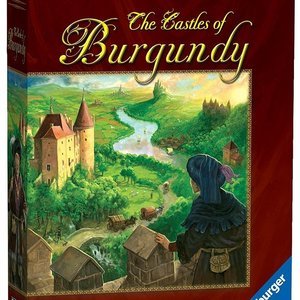
The Castles of Burgundy
Tabletop Game
The game is set in the Burgundy region of High Medieval France. Each player takes on the role of an...
Boardgames FeldGames
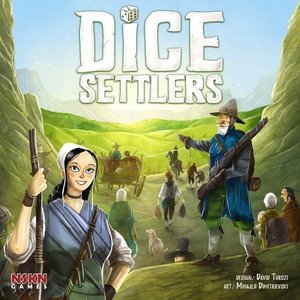
Dice Settlers
Tabletop Game
With a piece of land to call your own, a handful of resources, a few families and a head full of...
Boardgames Dicegames CivGames WildWestGames
Purple Phoenix Games (2266 KP) rated Doctor Who: Time of the Daleks in Tabletop Games
Sep 2, 2021
Doctor Who: Time of the Daleks (which I will carefully refer to as DW from here on out though I would never abbreviate to Dr.) is an adventure dice racing game, even though the only official tag is dice. In it, players take on the roles of different Doctor regenerations and will travel through time and space collecting companions, Timey-Wimey cards, and Sonic Charges in order to manipulate dice rolls to defeat Dilemmas and Time Anomalies that pop up at the absolute worst times.
To setup, follow the rulebook instructions – there are just too many components to detail here. The game takes up quite a bit of table space, so do make sure to use your largest table.
On a player’s turn they will be adding Sonic Charges, shuffling up companions, and rolling the TARDIS die to determine travel. Once at a location, the Doctor (and subsequent harem) can Adventure by assessing the challenge of dice results printed on the Location board plus the Dilemma disc combined. It is these icons that must be rolled (and possibly manipulated) in order to have a successful adventure. If successful, typically this involves a reward of moving the TARDIS pawn on the main Web of Time board closer to Gallifrey, in addition to other rewards. Failure on an adventure will typically result in the Dalek ship being moved further from Skaro and closer to Gallifrey.
Once the Doctors have had their turn, the Daleks will take a turn. Immediately move the Dalek ship one space on the Web of Time track towards Gallifrey, and if they have reached Gallifrey before any Doctor, or on the same turn as a Doctor, the Daleks win and the Doctors all lose. If not, play continues in this fashion until one of those win conditions are met, along with a couple more loss conditions I will leave you to discover.
This is a very pared-down synopsis of the rules, and I have intentionally left out several rules so as not to bog down my paraphrasing with minutia. Take this into consideration when determining if this is the game for you.
Components. All in all the components in DW are absolutely stellar! All the cardboard is thick and features great art and screencaps (which is a polarizing subject that I simply don’t mind). The dice are great quality, though I wish they had chosen a different color for the blue dice so that the TARDIS die would be the only blue in the box. The minis are great, and have interchangeable bases because throughout the game the Doctors may have to regenerate, thus switching to a different Doctor mid-game (awesome mechanic for this IP by the way).
Let me tell you why I like this DW game and why I do not. Firstly, the game is just too hard for me. Maybe it’s how I roll the dice, but I feel I am almost never in possession of enough resources to be able to reroll or manually manipulate my dice results enough to have the requisite amount of successful adventures. Some challenges require the Doctor to roll six dice, but then there are restrictions in play that drop a Doctor’s dice pool down to six, thus creating a you-must-roll-EXACTLY-what-you-need-to-win scenario that is tough to swallow for a dice game. Also, this next part is completely personal opinion, I wish that 10 was included in the starter box. I got my 11, and I appreciate that, but I feel like 10 is the most widely-popular Doctor in the franchise, or at least in New Who, so the ball was dropped here. I know I can purchase 10 in an expansion pack with 5 (and kudos to whomever made THAT combination), but I want him NOW.
Time travel games are so difficult to pull off, and with Doctor Who you HAVE to consider that time travel will play a very important part in gameplay. I believe this title handles it well, and even allows for multiple Doctors to work together (let’s not talk about time paradoxes for now). That is great and allows for excellent cooperative play, so I applaud the designer for that. I also enjoy the different abilities given by each different regeneration as well as what the companions each bring to the table. Perhaps a companion will add certain colors of dice to the Dice Pool, or allow the Doctor to switch out some of his generic dice for stronger and more specific dice, or simply allow rerolls of certain colors of dice. I dig that a lot. And seeing my precious companions in the game matched up to their Doctors fills me with a sense of nostalgia that I just do not feel in other games.
While this has been the subject of much deliberation on my part, I will be keeping my copy of the game, and will most definitely be adding 5 and 10 to the mix. I really want to like this game more than I do, and maybe having 10 in my arsenal is enough to do it, though I have my doubts. I love the Doctor Who IP and love dice games. I think this is a good game overall, and will continue to explore it with other gamers. Something will click, I’m sure of it. Purple Phoenix Games gives this one wibbly-wobbly 8 / 12. If you need a difficult dice game in your collection and also love the Doctors, pick up a copy. But also do yourself a favor and grab a copy of any expansion that includes your favorite Doctor – you will thank me later. Spoilers, sweetie, that’s coming in tomorrow’s post.
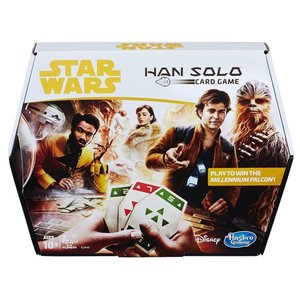
Star Wars Han Solo Card Game
Tabletop Game
The Han Solo Card Game is inspired by a legendary card game from the Star Wars universe! In this...
Purple Phoenix Games (2266 KP) rated Elder Sign in Tabletop Games
Jul 16, 2019 (Updated Aug 21, 2019)
Disclaimer: There are many expansions for Elder Sign. I do not have any of them, nor do I have any gameplay experience with any of them. If and when I do get them added into my base game, I will either amend this review or write a new one! – L
In Elder Sign, players take on the roles of Investigators who must use their supernatural knowledge and keen wit to seal dimensional portals and prevent the Ancient Ones from entering our world and destroying humanity. Just another day at the office, right? Players take turns rolling dice to fight monsters and complete adventures that will reward them with artifacts, health and/or sanity, clues, or even Elder Signs – the symbols necessary for sealing away the Ancient Ones for good. Be careful, though – if you fail to complete an adventure, you will be harshly punished! I’m talking losing health and sanity, accidentally summoning monsters, or even bringing the Ancient One one step closer to our world! As a solo game, Elder Sign plays the same way as it would in a group setting. The only difference is that the solo player cannot use the ‘Assisting’ ability because there are no other players who can offer you aid. Besides that, gameplay remains the same – even a lone Investigator can put their dice to good use to ward off evil!
I enjoy playing Elder Sign as a solo game. Although mostly dominated by dice rolling, there is a fair amount of strategy required for this game. I don’t feel like I’m mindlessly rolling dice – I have to decide which adventures are attainable with my given items, and which rewards benefit me the most in my overall task. There are rewards and consequences to be weighed with every decision, so action must be taken with great thought. Because of the strategic implications, Elder Sign keeps me thoroughly engaged, even when playing solo, and that’s one reason why I keep coming back to it.
On the flip side, one thing that isn’t my favorite about Elder Sign is its reliance on dice rolls to progress in the game. Yeah, I know, it’s a dice game – what did I expect? Sometimes, though, you just can’t roll to save your life (quite literally, in this game) and that can make the game frustrating to play. A series of poor rolls can feel like they completely negate any strategy you’ve enacted and can unravel your entire plan. On a good dice-rolling day for me, I love this game! On a not-so-good dice-rolling day, I find it a little harder to enjoy myself. But hey – if it was totally easy, it wouldn’t be fun, right? One positive of this, I guess, is that I always have to be adjusting my strategy to take the current dice into account. I can’t just pick one strategy and run with it since almost all outcomes are dependent on the luck of the roll! Elder Sign keeps me on my toes, that’s for sure.
I got Elder Sign from Travis as a birthday present last year, and it has been a good addition to my collection. There is enough going on to keep me engaged the entire game, but not so much that I feel overwhelmed. And yeah, maybe I’m not always the greatest dice-roller, but that just makes me adapt my strategy to deal with the current situation. I have read that adding expansions makes the game even more enjoyable, and hopefully one of these days I’ll get to experience that for myself. For the time being, though, I’m content with the base game. If you enjoy Elder Sign, I recommend you try it solo – it doesn’t feel any different to play, and I think you’ll enjoy it just as much as a group game!
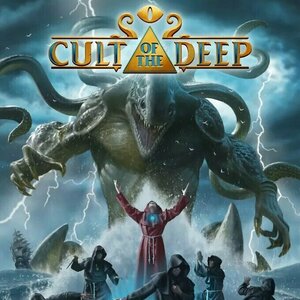


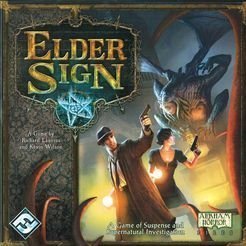
Matthew Krueger (10051 KP) Feb 25, 2021